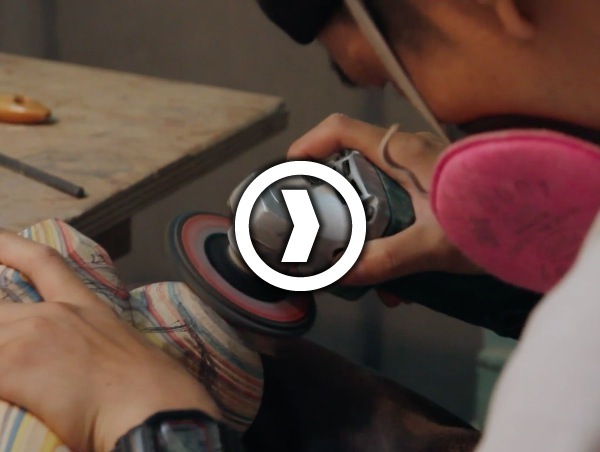
作品上如此熟悉的花纹,你说不定一样就能识别“这不是给Berrics做奖杯用的木料吗”,没错,这就是来自Haroshi的作品,Haroshi是为艺术家,他喜欢用废弃板面拼接做出各种形状雕塑,现在就跟随镜头一起体会这位艺术家从早出门的一天生活吧
Haroshi makes his art pieces recycling old used skateboards. To Haroshi, his art pieces are equal to his skateboards, and that means they are his life itself. They’re his communication tool with both himself, and the outside world.
His creations are born through styles such as wooden mosaic, dots, and pixels; where each element, either cut out in different shapes or kept in their original form, are connected in different styles, and shaven into the form of the final art piece. Haroshi became infatuated with skateboarding in his early teens, and is still a passionate skater at present. He knows thoroughly all the parts of the skateboard deck, such as the shape, concave, truck, and wheels. He often feels attached to trucks with the shaft visible, goes around picking up and collecting broken skateboard parts, and feels reluctant to throw away crashed skateboards. It’s only natural that he began to make art pieces (i.e. recycling) by using skateboards. To Haroshi, his art pieces are equal to his skateboards, and that means they are his life itself. They’re his communication tool with both himself, and the outside world.
The most important style of Haroshi’s three-dimensional art piece is the wooden mosaic. In order to make a sculpture out of a thin skateboard deck, one must stack many layers. But skate decks are already processed products, and not flat like a piece of wood freshly cut out from a tree. Moreover, skateboards may seem like they’re all in the same shape, but actually, their structure varies according to the factory, brand, and popular skaters’ signature models. With his experience and almost crazy knowledge of skateboards, Haroshi is able to differentiate from thousands of used deck stocks, which deck fits with which when stacked. After the decks are chosen and stacked, they are cut, shaven, and polished with his favorite tools. By coincidence, this creative style of his is similar to the way traditional wooden Japanese Great Buddhas are built. 90% of Buddha statues in Japan are carved from wood, and built using the method of wooden mosaic; in order to save expense of materials, and also to minimize the weight of the statue. So this also goes hand in hand with Haroshi’s style of using skateboards as a means of recycling. Also, although one is not able to see from outside, there is a certain metal object that is buried inside his three-dimensional statue. The object is a broken skateboard part that was chosen from his collection of parts that became deteriorated and broke off from skateboards, or got damaged from a failed Big Make attempt. To Haroshi, to set this kind of metal part inside his art piece means to “give soul” to the statue. “Unkei,” a Japanese sculptor of Buddhas who was active in the 12th Century, whose works are most popular even today among the Japanese people; used to set a crystal ball called “Shin-Gachi-Rin (Heart Moon Circle)” in the position of the Buddha’s heart. This would become the soul of the statue. So the fact that Haroshi takes the same steps in his creation may be a natural reflection of his spirit and aesthetic as a Japanese.














Post a comment